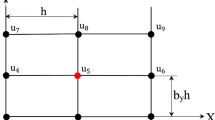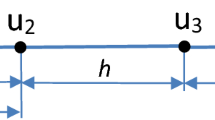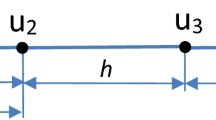Abstract
Here, we extend the optimal local truncation error method (OLTEM) recently developed in our papers to the 3D time-independent Helmholtz equation on irregular domains. Trivial unfitted Cartesian meshes and simple 27-point discrete stencil equations are used for 3D irregular domains. The stencil coefficients for the new approach are assumed to be unknown and are calculated by the minimization of the local truncation error of the stencil equations. This provides the optimal order of accuracy of the proposed technique. At similar 27-point stencils, the accuracy of OLTEM is two orders higher for the Dirichlet boundary conditions and one order higher for the Neumann boundary conditions compared to that for linear finite elements. The numerical results for irregular domains also show that at the same number of degrees of freedom, OLTEM is even much more accurate than high-order (up to the fifth order) finite elements with much wider stencils. Compared to linear finite elements with similar 27-point stencils, at accuracy of 0.1% OLTEM decreases the number of degrees of freedom by a factor of greater than 1000. This leads to a huge reduction in computation time. The new approach can be equally applied to the Helmholtz and screened Poisson equations.














Similar content being viewed by others
References
Kacimi AE, Laghrouche O, Mohamed M, Trevelyan J (2019) Bernstein–Bézier based finite elements for efficient solution of short wave problems. Comput Methods Appl Mech Eng 343:166–185
Lieu A, Gabard G, Bériot H (2016) A comparison of high-order polynomial and wave-based methods for Helmholtz problems. J Comput Phys 321:105–125
Celiker E, Lin P (2019) A highly-accurate finite element method with exponentially compressed meshes for the solution of the Dirichlet problem of the generalized Helmholtz equation with corner singularities. J Comput Appl Math 361:227–235
Magoulès F, Zhang H (2018) Three-dimensional dispersion analysis and stabilized finite element methods for acoustics. Comput Methods Appl Mech Eng 335:563–583
Lam CY, Shu C-W (2017) A phase-based interior penalty discontinuous Galerkin method for the Helmholtz equation with spatially varying wavenumber. Comput Methods Appl Mech Eng 318:456–473
Diwan GC, Mohamed MS (2019) Pollution studies for high order isogeometric analysis and finite element for acoustic problems. Comput Methods Appl Mech Eng 350:701–718
Harari I (2006) A survey of finite element methods for time-harmonic acoustics. Comput Methods Appl Mech Eng 195(13):1594–1607
Babuška I, Ihlenburg F, Paik ET, Sauter SA (1995) A generalized finite element method for solving the Helmholtz equation in two dimensions with minimal pollution. Comput Methods Appl Mech Eng 128(3):325–359
Biermann J, von Estorff O, Petersen S, Wenterodt C (2009) Higher order finite and infinite elements for the solution of Helmholtz problems. Comput Methods Appl Mech Eng 198(13):1171–1188
Fang J, Qian J, Zepeda-Núñez L, Zhao H (2018) A hybrid approach to solve the high-frequency Helmholtz equation with source singularity in smooth heterogeneous media. J Comput Phys 371:261–279
Christodoulou K, Laghrouche O, Mohamed M, Trevelyan J (2017) High-order finite elements for the solution of Helmholtz problems. Comput Struct 191:129–139
Gerdes K, Ihlenburg F (1999) On the pollution effect in FE solutions of the 3D-Helmholtz equation. Comput Methods Appl Mech Eng 170(1):155–172
Demkowicz L, Gopalakrishnan J, Muga I, Zitelli J (2012) Wavenumber explicit analysis of a DPG method for the multidimensional Helmholtz equation. Comput Methods Appl Mech Eng 213–216:126–138
Mascotto L, Perugia I, Pichler A (2019) A nonconforming Trefftz virtual element method for the Helmholtz problem: numerical aspects. Comput Methods Appl Mech Eng 347:445–476
Yang M, Perrey-Debain E, Nennig B, Chazot J-D (2018) Development of 3D PUFEM with linear tetrahedral elements for the simulation of acoustic waves in enclosed cavities. Comput Methods Appl Mech Eng 335:403–418
Eslaminia M, Guddati MN (2016) A double-sweeping preconditioner for the Helmholtz equation. J Comput Phys 314:800–823
Amara M, Calandra H, Dejllouli R, Grigoroscuta-Strugaru M (2012) A stable discontinuous Galerkin-type method for solving efficiently Helmholtz problems. Comput Struct 106–107:258–272
Banerjee S, Sukumar N (2017) Exact integration scheme for planewave-enriched partition of unity finite element method to solve the Helmholtz problem. Comput Methods Appl Mech Eng 317:619–648
Strouboulis T, Babuška I, Hidajat R (2006) The generalized finite element method for Helmholtz equation: theory, computation, and open problems. Comput Methods Appl Mech Eng 195(37):4711–4731
Chaumont-Frelet T (2016) On high order methods for the heterogeneous Helmholtz equation. Comput Math Appl 72(9):2203–2225
He Z, Liu G, Zhong Z, Wu S, Zhang G, Cheng A (2009) An edge-based smoothed finite element method (ES-FEM) for analyzing three-dimensional acoustic problems. Comput Methods Appl Mech Eng 199(1):20–33
Wu Z, Alkhalifah T (2018) A highly accurate finite-difference method with minimum dispersion error for solving the Helmholtz equation. J Comput Phys 365:350–361
You X, Chai Y, Li W (2019) A coupled FE-meshfree method for Helmholtz problems using point interpolation shape functions and edge-based gradient smoothing technique. Comput Struct 213:1–22
Coox L, Deckers E, Vandepitte D, Desmet W (2016) A performance study of NURBS-based isogeometric analysis for interior two-dimensional time-harmonic acoustics. Comput Methods Appl Mech Eng 305:441–467
Dinachandra M, Raju S (2018) Plane wave enriched partition of unity isogeometric analysis (PUIGA) for 2D-Helmholtz problems. Comput Methods Appl Mech Eng 335:380–402
Khajah T, Villamizar V (2019) Highly accurate acoustic scattering: isogeometric analysis coupled with local high order farfield expansion ABC. Comput Methods Appl Mech Eng 349:477–498
Galagusz R, McFee S (2019) An iterative domain decomposition, spectral finite element method on non-conforming meshes suitable for high frequency Helmholtz problems. J Comput Phys 379:132–172
Gordon D, Gordon R, Turkel E (2015) Compact high order schemes with gradient-direction derivatives for absorbing boundary conditions. J Comput Phys 297:295–315
Cheng D, Liu Z, Wu T (2015) A multigrid-based preconditioned solver for the Helmholtz equation with a discretization by 25-point difference scheme. Math Comput Simul 117:54–67
Turkel E, Gordon D, Gordon R, Tsynkov S (2013) Compact 2D and 3D sixth order schemes for the Helmholtz equation with variable wave number. J Comput Phys 232(1):272–287
Britt S, Tsynkov S, Turkel E (2018) Numerical solution of the wave equation with variable wave speed on nonconforming domains by high-order difference potentials. J Comput Phys 354:26–42
Jones TN, Sheng Q (2019) Asymptotic stability of a dual-scale compact method for approximating highly oscillatory Helmholtz solutions. J Comput Phys 392:403–418
Wu T (2017) A dispersion minimizing compact finite difference scheme for the 2D Helmholtz equation. J Comput Appl Math 311:497–512
Wu T, Xu R (2018) An optimal compact sixth-order finite difference scheme for the Helmholtz equation. Comput Math Appl 75(7):2520–2537
Stolk CC (2016) A dispersion minimizing scheme for the 3-D Helmholtz equation based on ray theory. J Comput Phys 314:618–646
Vos P, van Loon R, Sherwin S (2008) A comparison of fictitious domain methods appropriate for spectral/hp element discretisations. Comput Methods Appl Mech Eng 197(25–28):2275–2289
Burman E, Hansbo P (2010) Fictitious domain finite element methods using cut elements: I. A stabilized Lagrange multiplier method. Comput Methods Appl Mech Eng 199(41–44):2680–2686
Rank E, Ruess M, Kollmannsberger S, Schillinger D, Duster A (2012) Geometric modeling, isogeometric analysis and the finite cell method. Comput Methods Appl Mech Eng 249–252:104–115
Fries T, Omerović S, Schöllhammer D, Steidl J (2017) Higher-order meshing of implicit geometries-part I: integration and interpolation in cut elements. Comput Methods Appl Mech Eng 313:759–784
Hoang T, Verhoosel CV, Auricchio F, van Brummelen EH, Reali A (2017) Mixed isogeometric finite cell methods for the Stokes problem. Comput Methods Appl Mech Eng 316:400–423
May S, Berger M (2017) An explicit implicit scheme for cut cells in embedded boundary meshes. J Sci Comput 71(3):919–943
Kreisst H-O, Petersson NA (2006) An embedded boundary method for the wave equation with discontinuous coefficients. SIAM J Sci Comput 28(6):2054–2074
Kreiss H-O, Petersson NA (2006) A second order accurate embedded boundary method for the wave equation with Dirichlet data. SIAM J Sci Comput 27(4):1141–1167
Jomaa Z, Macaskill C (2010) The Shortley–Weller embedded finite-difference method for the 3D Poisson equation with mixed boundary conditions. J Comput Phys 229(10):3675–3690
Jomaa Z, Macaskill C (2005) The embedded finite difference method for the Poisson equation in a domain with an irregular boundary and Dirichlet boundary conditions. J Comput Phys 202(2):488–506
Hellrung JL Jr, Wang L, Sifakis E, Teran JM (2012) A second order virtual node method for elliptic problems with interfaces and irregular domains in three dimensions. J Comput Phys 231(4):2015–2048
Chen L, Wei H, Wen M (2017) An interface-fitted mesh generator and virtual element methods for elliptic interface problems. J Comput Phys 334:327–348
Bedrossian J, von Brecht JH, Zhu S, Sifakis E, Teran JM (2010) A second order virtual node method for elliptic problems with interfaces and irregular domains. J Comput Phys 229(18):6405–6426
Mattsson K, Almquist M (2017) A high-order accurate embedded boundary method for first order hyperbolic equations. J Comput Phys 334:255–279
Schwartz P, Barad M, Colella P, Ligocki T (2006) A Cartesian grid embedded boundary method for the heat equation and Poisson’s equation in three dimensions. J Comput Phys 211(2):531–550
Colella P, Graves DT, Keen BJ, Modiano D (2006) A Cartesian grid embedded boundary method for hyperbolic conservation laws. J Comput Phys 211(1):347–366
Crockett R, Colella P, Graves D (2011) A Cartesian grid embedded boundary method for solving the Poisson and heat equations with discontinuous coefficients in three dimensions. J Comput Phys 230(7):2451–2469
McCorquodale P, Colella P, Johansen H (2001) A Cartesian grid embedded boundary method for the heat equation on irregular domains. J Comput Phys 173(2):620–635
Angel JB, Banks JW, Henshaw WD (2018) High-order upwind schemes for the wave equation on overlapping grids: Maxwell’s equations in second-order form. J Comput Phys 352:534–567
Uddin H, Kramer R, Pantano C (2014) A Cartesian-based embedded geometry technique with adaptive high-order finite differences for compressible flow around complex geometries. J Comput Phys 262:379–407
Main A, Scovazzi G (2018) The shifted boundary method for embedded domain computations. Part I: Poisson and Stokes problems. J Comput Phys 372:972–995
Song T, Main A, Scovazzi G, Ricchiuto M (2018) The shifted boundary method for hyperbolic systems: embedded domain computations of linear waves and shallow water flows. J Comput Phys 369:45–79
Hosseinverdi S, Fasel HF (2018) An efficient, high-order method for solving Poisson equation for immersed boundaries: combination of compact difference and multiscale multigrid methods. J Comput Phys 374:912–940
Huang J, Bathe K-J (2019) Quadrilateral overlapping elements and their use in the amore paradigm. Comput Struct 222:25–35
Rank E, Kollmannsberger S, Sorger C, Duster A (2011) Shell finite cell method: a high order fictitious domain approach for thin-walled structures. Comput Methods Appl Mech Eng 200(45–46):3200–3209
Kreiss H-O, Petersson NA, Ystrom J (2004) Difference approximations of the Neumann problem for the second order wave equation. SIAM J Numer Anal 42(3):1292–1323
Johansen H, Colella P (1998) A Cartesian grid embedded boundary method for Poisson’s equation on irregular domains. J Comput Phys 147(1):60–85
Medvinsky M, Tsynkov S, Turkel E (2016) Solving the Helmholtz equation for general smooth geometry using simple grids. Wave Motion 62:75–97
Idesman A, Dey B (2020) A new numerical approach to the solution of the 2-D Helmholtz equation with optimal accuracy on irregular domains and Cartesian meshes. Comput Mech 65:1189–1204
Idesman A, Dey B (2019) A new 3-D numerical approach to the solution of PDEs with optimal accuracy on irregular domains and Cartesian meshes. Comput Methods Appl Mech Eng 354:568–592
Idesman A, Dey B (2020) The treatment of the Neumann boundary conditions for a new numerical approach to the solution of PDEs with optimal accuracy on irregular domains and Cartesian meshes. Comput Methods Appl Mech Eng 365:112985
Singer I, Turkel E (2006) Sixth-order accurate finite difference schemes for the Helmholtz equation. J Comput Acoust 14(03):339–351
Sutmann G (2007) Compact finite difference schemes of sixth order for the Helmholtz equation. J Comput Appl Math 203(1):15–31
Idesman A, Dey B (2020) A high-order numerical approach with Cartesian meshes for modeling of wave propagation and heat transfer on irregular domains with inhomogeneous materials. Comput Methods Appl Mech Eng 370:113249
Idesman A, Dey B (2017) The use of the local truncation error for the increase in accuracy of the linear finite elements for heat transfer problems. Comput Methods Appl Mech Eng 319:52–82
Bathe KJ (1996) Finite element procedures. Prentice-Hall Inc., Upper Saddle River
Langtangen HP, Linge S (2017) Finite difference computing with PDEs. Springer, Berlin
Idesman A, Dey B (2020) Compact high-order stencils with optimal accuracy for numerical solutions of 2-D time-independent elasticity equations. Comput Methods Appl Mech Eng 360:112699
Idesman A, Dey B (2020) Accurate numerical solutions of 2-D elastodynamics problems using compact high-order stencils. Comput Struct 229:106160
Acknowledgements
The research has been supported in part by the NSF Grant CMMI-1935452 and by Texas Tech University.
Author information
Authors and Affiliations
Corresponding author
Additional information
Publisher's Note
Springer Nature remains neutral with regard to jurisdictional claims in published maps and institutional affiliations.
Appendices
Appendix 1: The coefficients \(b_p\) used in Eq. (10) in Sect. 2.2
The first five coefficients \(b_p\) (\(p=1,2,\ldots ,5\)) used in Eq. (10) are presented below. All coefficients \(b_p\) used in Eq. (10) are given in the attached files ‘b-coeff-1.pdf’ and ‘b-coeff-1.nb’.
Eq. (10):
Appendix 2: The coefficients \(b_p\) used in Eq. (10) for the Neumann boundary conditions in Sect. 2.3
The first five coefficients \(b_p\) (\(p=1,2,\ldots ,5\)) used in Eq. (10) are presented below. All coefficients \(b_p\) used in Eq. (10) are given in the attached files ‘b-coeff-2.pdf’ and ‘b-coeff-2.nb’.
Equation (10):
Rights and permissions
About this article
Cite this article
Idesman, A., Dey, B. The numerical solution of the 3D Helmholtz equation with optimal accuracy on irregular domains and unfitted Cartesian meshes. Engineering with Computers 38, 4979–5001 (2022). https://doi.org/10.1007/s00366-021-01547-9
Received:
Accepted:
Published:
Issue Date:
DOI: https://doi.org/10.1007/s00366-021-01547-9




